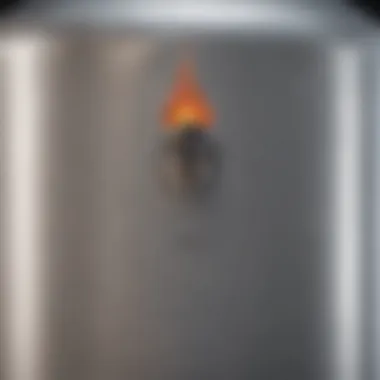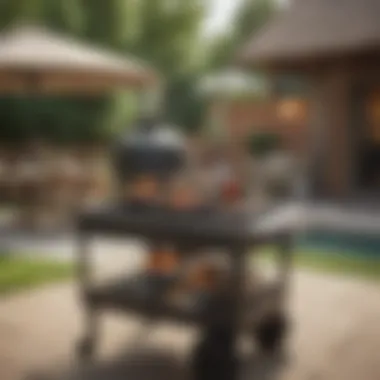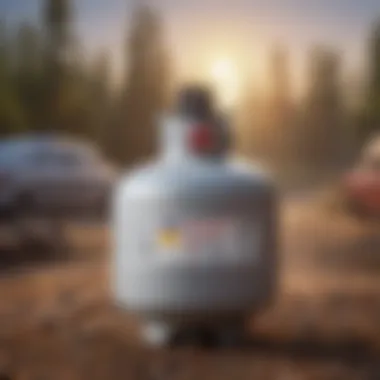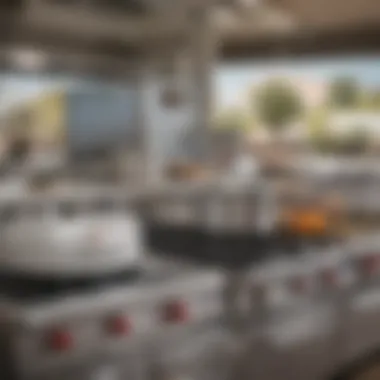Exploring Small Liquid Propane Tanks for Cooking


Intro
Small liquid propane tanks have become fundamental in the world of cooking. Culinary enthusiasts, both at home and in professional settings, are exploring these tanks to elevate their cooking experience. Understanding how these devices function is critical, whether one is grilling, frying, or using unique cooking techniques like sous vide.
These tanks offer versatility. You can find them powering everything from portable grills to outdoor kitchens. Their convenience can enhance various culinary settings, making them a valuable investment for those who love to cook outdoors or need efficient cooking solutions.
This article will break down the operation, components, safety measures, and advantages of small liquid propane tanks. We aim to educate both novices and experienced cooks, uncovering the essentials of maximizing culinary endeavors with propane-fueled appliances.
Understanding Small Liquid Propane Tanks
Small liquid propane tanks play a critical role in the cooking and culinary domain. Their compact size and portability make them especially useful for numerous cooking settings, from casual backyard grilling to commercial kitchens where space is a consideration. Culinary enthusiasts can benefit from understanding these tanks, as they offer both convenience and efficiency in various cooking processes.
Definition and Purpose
Small liquid propane tanks are designed to store propane gas in liquid form under pressure. This gas, when released, evaporates and becomes a vapor that can be ignited for cooking. Their primary purpose is to provide a readily available fuel source for appliances such as grills, portable stoves, and ovens.
In many residential and outdoor situations, these tanks serve the needs of those seeking freedom from traditional gas lines. They allow the use of gas-fired appliances almost anywhere, enabling culinary activities in remote locations. Understanding this definition is crucial for anyone looking to maximize the benefits of propane in their cooking endeavors.
Key Components
Understanding the key components of small liquid propane tanks is essential for safe and effective use. Each part plays a role in the overall functioning and efficiency of the propane system.
Tank body
The tank body is the core structure that houses the propane. Made from durable materials, it is designed to withstand internal pressure caused by the liquefied gas. A vital characteristic of tank bodies is their pressure rating; this determines how much propane can safely be stored.
The tank's unique feature is its ability to efficiently store liquid propane, making it a popular choice among culinary enthusiasts who appreciate the reliability it brings. Properly maintained tank bodies can last many years, but neglect or damage can lead to hazards.
Valves and fittings
Valves and fittings are crucial for the operation of small liquid propane tanks. They control the flow of propane from the tank to the appliance. A key characteristic is their ability to provide both safety and functionality; appropriate valves can help prevent leaks.
These components must be chosen correctly to ensure compatibility with kitchen equipment. An advantage of high-quality valves and fittings is their longevity. However, poor models can lead to leaking, posing risks during cooking. Therefore, selecting the right valves can enhance both safety and cooking performance.
Regulator
The regulator is an important device that reduces high pressure from the tank to a manageable level suitable for appliances. One notable feature of a regulator is its ability to provide a consistent gas flow, crucial for even cooking and baking.
A benefit of using a reliable regulator is that it maintains the pressure, ensuring the equipment operates efficiently. An unreliable regulator can result in fluctuating performance, affecting the cooking process, which is undesirable for serious cooks.
Safety devices
Safety devices are incorporated into small liquid propane tanks to prevent accidents. These devices include pressure relief valves and excess flow valves. A defining characteristic of safety devices is their automatic response to pressure changes, ensuring a secure operating environment.


Their presence is a major advantage, decreasing the likelihood of leaks or explosions, which are significant concerns in gas use. Users must ensure these devices are functioning properly. Failure to do so can lead to potentially severe consequences during cooking.
Operation of Small Liquid Propane Tanks
Understanding how small liquid propane tanks operate is essential for those who want to use them effectively in culinary settings. Propane tanks provide a reliable and portable source of fuel that can enhance cooking experiences, especially during outdoor activities, barbecues or camping. A thorough grasp of how propane is stored, dispensed, and connected to appliances ensures safety and maximizes performance.
How Propane is Stored and Dispensed
Propane is stored as a liquid within a specially designed tank. These tanks are constructed to withstand high pressure. The liquid propane lies at the bottom of the tank. When gas is needed, a specific valve allows the liquid to vaporize. This transition occurs because of the lower pressure once the valve opens.
The main concept in propane dispensing is maintaining a consistent flow. As propane vaporizes, it occupies more space than the liquid form, allowing for the efficient supply to cooking appliances. Understanding this helps users recognize the importance of tank levels. Before each use, checking the gauge for the gas level is a good practice.
Additionally, ensure the tank is stored upright. Placing it on its side affects the dispensing process and could cause issues when attempting to use the appliances.
Connecting to Appliances
Connecting a small liquid propane tank to cooking appliances requires careful attention to detail. The process starts with the appropriate connections; each appliance should come with a compatible regulator and hose. Carefully inspect these components for wear or any damage before use.
Once verified, the connection involves attaching the regulator to the tank's outlet valve. It is crucial to turn the connection securely to prevent any leaks. After that, the appliance itself can be connected to the regulator.
Before lighting any burners on the appliance, double-check the connections. Using soapy water on connections can help identify leaks; bubbles signify escaping gas. In the event of a leak, rectify it before proceeding.
Finally, always follow the manufacturer's instructions regarding the specific connection requirements and safety protocols. Proper connections facilitate a seamless cooking experience. They ensure that the propane flows efficiently while minimizing risks.
Safety Considerations
Safety should always be paramount when using small liquid propane tanks, especially in culinary environments where the stakes often include both the quality of food and the wellbeing of individuals. Understanding safety measures allows culinary enthusiasts to enjoy propane-fueled cooking with confidence, minimizing risks associated with gas usage.
Proper Handling and Use
Handling small liquid propane tanks requires a sound understanding of their nature. Propane is flammable; hence, knowing how to manage and operate the tank properly is crucial. Always inspect the tank for any signs of damage or corrosion before use. The valve must be closed securely when not in use, and connections should be made carefully to prevent leaks. One effective method for checking leaks involves using a mixture of soap and water. If bubbling occurs, there is a leak that needs attention.
It is essential also to operate the tank and the connected appliances in well-ventilated areas. Such spaces help to disperse any possible gas accumulation. Another important aspect includes never to leave the tank unattended while in use, to avoid mishaps. Train anyone who may handle the tank on proper usage and safety protocols, ensuring everybody is informed about safety measures.
Storage Guidelines
Storage of small liquid propane tanks involves adhering to strict guidelines to prevent accidents. Propane tanks should always be stored upright in a cool, ventilated space, away from direct sunlight. Temperature extremes can affect the integrity of the tank and its contents.
Invalid storage can lead to a pressing risk of explosion. Avoid storing propane tanks indoors, especially near heat sources or enclosed spaces. It is advisable to keep the tank at least 10 feet away from any ignition sources and to secure it to prevent tipping.
Emergency Procedures
In any situation involving a propane tank, having well-defined emergency procedures is vital. If there is a noticeable smell of gas or a leak, evacuate the area immediately and do not attempt to light the appliance. Instead, take steps to ensure proper ventilation by opening the windows and doors, if it is safe to do so.


In the event of a fire, never use water to extinguish, as it could worsen the situation; instead, have a fire extinguisher rated for gas fires on hand. The use of a Class B fire extinguisher is recommended. If you cannot control the fire, contact emergency services immediately. Furthermore, keep local emergency numbers visible and accessible.
Lastly, understanding how to turn off the propane supply in case of emergencies is vital knowledge. All users of propane should be trained in these emergency procedures, ensuring everyone involved is prepared for any situation that may arise. This proactive approach enhances safety and fosters a responsible cooking practice that celebrates the benefits of propane while mitigating risks.
Applications in Culinary Settings
Small liquid propane tanks serve multiple essential applications in culinary environments. Their versatility enhances cooking techniques and provides options for various types of preparation methods. Understanding how these tanks can be utilized is crucial for culinary enthusiasts looking to expand their experience in cooking. From grilling to portable solutions, propane tanks add flexibility to food preparation.
Grilling and Outdoor Cooking
Grilling stands out as one of the most popular uses for small liquid propane tanks. The combination of high heat and convenient fuel source makes propane an exceptional choice for outdoor cooking. Grilling not only imparts unique flavors to food but also creates social gatherings centered around the cooking experience.
Using propane grills is straightforward. The setup usually involves connecting the tank to the grill's burner system with the right fittings. A reliable regulator is also crucial, ensuring steady gas flow to achieve the desired temperature.
Benefits of Using Propane for Grilling:
- Quick heating: Propane grills heat up faster than many charcoal alternatives.
- Control: Propane allows cooks to manage heat with precision.
- Clean and efficient: Propane burns more cleanly than charcoal, producing less soot and leaving less residue on food.
Portable Cooking Solutions
Portable cooking solutions utilizing small propane tanks are ideal for camping trips or tailgating events. This mobility allows culinary enthusiasts to prepare meals outdoors without relying on traditional power sources. These tanks can easily be transported and connected to various cooking appliances, such as portable stoves and compact grills.
Features of Portable Cooking with Propane:
- Lightweight and compact: Small tanks are easy to carry.
- Versatility: They can be used with different cooking tools, including stoves, burners, and grills.
- Ease of use: Starting a propane stove is often simpler than starting a fire or heating charcoal.
"Portable propane cooking devices offer culinary freedom like no other, enabling enthusiasts to cook in diverse locations with minimal hassle."
Commercial Use in Food Service
In a commercial context, small liquid propane tanks are vital for food service operations. Many food trucks, cafes, and event catering companies rely on propane for their cooking needs. The consistent heat and reliability offered by propane is especially beneficial in fast-paced environments.
Key Advantages for Commercial Use:
- Cost-effective: Propane tends to be more affordable than electric alternatives in many regions.
- Independence from electrical grid: This feature is vital in outdoor venues or remote locations.
- Efficiency: High heat output allows for faster cooking, which is crucial in busy kitchens.
Comparative Analysis
The comparative analysis of small liquid propane tanks versus electric cooking systems is crucial in understanding the advantages and drawbacks of each option in culinary applications. This section aims to provide a clear overview of the two technologies, allowing culinary enthusiasts to make informed decisions based on their preferences and specific cooking needs. Evaluating these systems can highlight important aspects, such as food flavor, versatility, and environmental impact, which are significant when choosing the right equipment.
Propane vs. Electric Cooking
When comparing propane and electric cooking, several factors come into play. Propane cooking is often favored for its high heat output, making it ideal for grilling, searing, and achieving a true flame experience. Many chefs and home cooks find this type of cooking creates more flavorful meals since the intense heat from propane enables better caramelization and browning of food. Moreover, propane tanks can be used in areas without electrical outlets, providing flexibility in outdoor cooking.


Conversely, electric cooking appliances generally offer precision temperature control, which can be beneficial for techniques like baking and simmering. These appliances tend to heat more evenly, thus reducing the risk of hot spots. Electric systems also often come with safety features that can be appealing to less experienced cooks. Both systems have their merits and drawbacks; the choice often hinges on personal cooking styles and desired outcomes.
Efficiency and Cost Factors
Evaluating the efficiency and cost factors of propane and electric cooking is essential for culinary enthusiasts looking to optimize their cooking experience. Propane appliances are generally considered more energy-efficient than electric ones, particularly when used outdoors. They can heat up quickly and provide more energy-per-btu than electric options. However, it's important to consider the cost of propane gas, which can fluctuate based on market prices.
On the other hand, electric cooking can often reduce overall equipment cost due to lower initial investments. Electric appliances are frequently more accessible, and operating costs can be manageable depending on local electricity rates. Keep in mind that electric systems might incur higher energy bills, especially with heavy use. When deciding between the two, consideration of both initial and ongoing costs will help determine the best fit for your cooking context.
Maintenance of Small Liquid Propane Tanks
Proper maintenance of small liquid propane tanks is crucial for both safety and efficiency. Given their role in culinary settings, neglecting maintenance can lead to hazardous situations and performance issues. Regular checks not only ensure the tank operates smoothly but also extend its life. The peace of mind that comes from knowing your equipment is in optimal condition is an invaluable benefit for any culinary enthusiast.
Regular Maintenance Checks
Conducting regular maintenance checks is essential for any small liquid propane tank. Users should be vigilant about scheduling inspections at least once a year, or more frequently if the tank is used heavily. During these checks, the focus should be on examining key components including:
- Tank body: Look for rust or dents that may weaken the tank.
- Valves and fittings: Ensure they are secure and not leaking.
- Regulator: Check for proper function and signs of damage.
- Safety devices: Inspect emergency systems to ensure they are operational.
Additionally, propane tank users should check the expiration date stamped on the tank itself. If the tank is expired, it must not be used until it is recertified or replaced.
Signs of Wear and Tear
Identifying signs of wear and tear is vital for ongoing safety and performance. Several indicators can help users determine the state of their propane tank. These include:
- Visual damage: Any visible rust, corrosion, or dents can indicate serious structural issues.
- Odor: A distinct smell of propane or any unusual odors may suggest a leak.
- Unusual sounds: Hissing or whistling noises near connections can signal leaks or faulty equipment.
- Pressure issues: If the pressure gauge shows inconsistent readings, this may require immediate attention.
Regular attention to these details not only enhances the lifespan of propane tanks but also ensures a safer cooking experience.
Future Trends in Propane Usage
As the culinary world evolves, so too does the technology that supports it. Understanding future trends in propane usage is essential for culinary enthusiasts looking to stay updated with the latest advancements in cooking. The relevance of this topic lies in its potential to influence convenience, efficiency, and sustainability in culinary practices. Advances in propane technology can lead to improved cooking outcomes while minimizing environmental impact.
Innovative Propane Appliances
The market is witnessing a surge in innovative propane appliances designed to enhance cooking experiences. These appliances are often equipped with enhanced safety features and efficiency measures. Examples include propane-powered induction cooktops and portable grills designed for various cooking scenarios.
- Smart Grills: Many new propane grills come with smart technology integration, allowing users to control temperatures and cooking times via smartphones. This technology ensures precise cooking and monitoring.
- Portable Cookers: Lightweight and compact propane cookers cater to outdoor enthusiasts. With advancements in design, they are now more efficient and offer better heat retention.
- Hybrid Systems: Some manufacturers are producing hybrid cooking systems that allow users to switch between propane and other energy sources. This flexibility can improve culinary creativity without sacrificing performance.
These innovations not only cater to the growing needs of culinary enthusiasts but also demonstrate a commitment to enhance user experience and accessibility.
Sustainability Considerations
The role of propane in cooking is becoming increasingly scrutinized under the lens of sustainability. As environmental concerns grow, the culinary industry is seeking ways to reduce its carbon footprint. Propane, being a cleaner-burning fossil fuel compared to coal and oil, presents some sustainability advantages. However, future trends will demand more than just cleaner combustion.
- Renewable Propane: This emerging fuel is derived from organic waste. It is chemically similar to traditional propane, providing the same performance. Using renewable solutions can significantly reduce greenhouse gas emissions.
- Efficient Usage Practices: Culinary professionals are encouraged to adopt practices that maximize fuel efficiency. Techniques such as using proper heat settings and maintaining appliances can prolong tank life and reduce waste.
- Regulatory Changes: Governments may implement stricter regulations on cooking fuels. Staying informed on such changes can help chefs and restaurant owners adapt their practices accordingly.
"Sustainability is not just a trend; it is a necessity for future generations. Evaluating the ways propane is utilized in culinary settings paves the way for responsible cooking practices."
These sustainability considerations reflect a shift towards environmentally friendly practices. Culinary enthusiasts can play a crucial role in promoting and adopting these innovations and practices, ensuring they are part of the growing movement toward a sustainable culinary landscape.















